After installing Boutiq on your Shopify store, going through the basic testing guide, and reviewing our FAQ, it’s time to consider your deployment options. Boutiq was designed to address many use cases and you can leverage the flexible options to fit your and your customers needs.
This guide is intended to help you think through the most common questions we’ve seen with other merchants and some of the best practices in using Boutiq.
While every store is different, there are still some common questions that almost every merchant needs to think through. The ultimate goal is to empower you to provide the best service possible to your customers while generating more sales by improving engagement, increasing conversion, and boosting AOV.
These questions and considerations generally fall under five categories:
- Operational
- Branding
- Engagement
- Conversion
- Advanced workflow and integration
The first operational question is typically, who is going to answer incoming calls?
If you have brick-and-mortar stores, you might want to leverage the talent you already have in the stores - they know your products and customers best, they're already trained, and their skill-set translates well into video selling.
If you’re an online-only store, we’ve seen merchants starting with their customer care team/lead, marketing staff, and/or the eCommerce team.
After seeing the potential ROI, you might want to consider hiring for this role, but at least initially almost all of our customers leverage their existing staff - whether at the store, at HQ, at the warehouse or at home. One of the advantages of Boutiq, is that you can use it from anywhere.
The question is how to start. Video calls are different from email, chat services, and even phone calls, in that you cannot multitask while on a video-call. You’re expected to be fully engaged with your customer. The first step here is to determine your initial availability hours - at what times do you want (and can afford) to answer your customer calls. You can set the store availability hours on the Boutiq Admin (under Calendar) and each of your hosts can also set her availability hours independently. During these times, you want to make sure that someone is indeed available to answer incoming calls.

You can also start offering the service by invitation only. You can choose not to have Boutiq visible on your online store and reach out to a selected set of your customers inviting them to call (or to schedule an appointment). In these cases you can use Call Links - these can be used in emails and/or social media and when clicked the Boutiq app will launch to start/schedule a call.
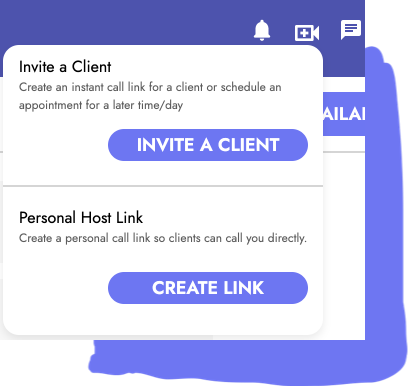
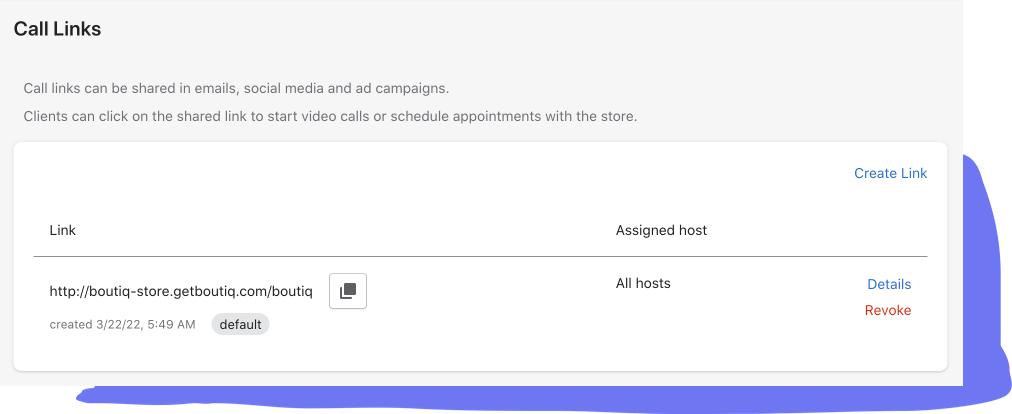
Another consideration here is whether you’d like to provide the service by appointment only or also allow instant calls. Each of these options has its own pros and cons. Scheduled/by-appointment calls are easier to staff and plan for - you can make sure you have a sales associate available for the call and can also use the time before the call to prepare for it. Some merchants like to do some homework on the client before the call - maybe asking her to fill a pre-call questionnaire to get to know her and her needs better, checking profile in your CRM, looking at her social media accounts, and even preparing a personal lookbook for her before the call. All of these will increase your conversion and improve the service you offer.
However, when your customers are browsing your store and would like to talk to someone NOW, you want to seize the opportunity and be available for her.
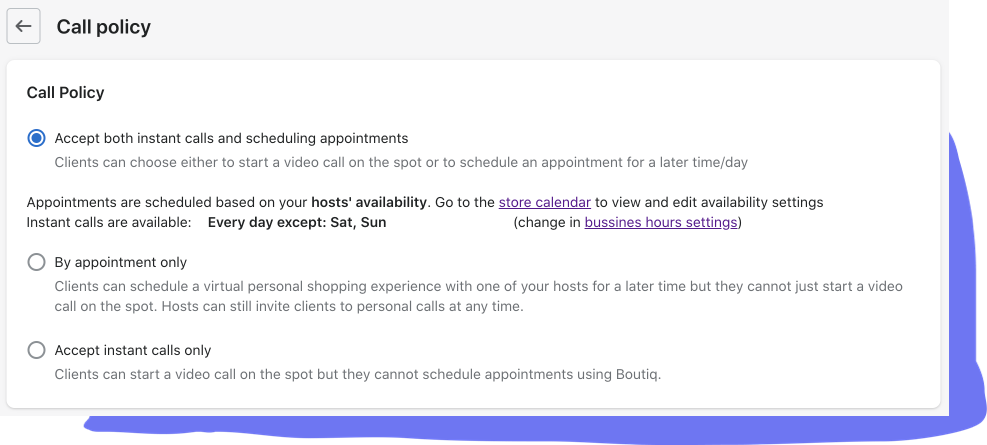
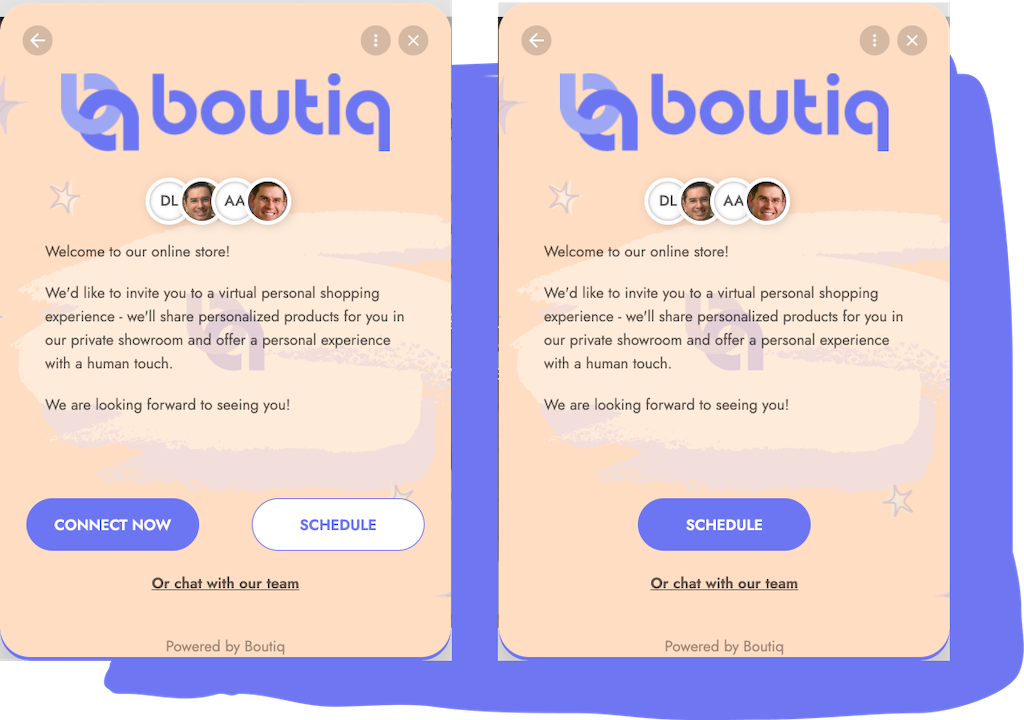
You also want to think through which device your sales associates use for the calls. Clients can of-course call from any device (mobile/tablet/desktop) but sales associates need to use a desktop/laptop or a tablet/iPhone.
We typically recommend using a device with a big screen that will allow your sales associate to take full advantage of all the information Boutiq provides during the call. But there are cases where an iPad might work better - for example: for sales-associates at the store, it’s easier to walk around with an iPad and maybe share with the customer some items on the floor. If you do plan on using an iPad (or an iPhone), make sure to download the Boutiq iPad or iPhone app from the Apple App Store.
Realizing that every store and every brand has its own unique branding, styling, and voice, we designed Boutiq such that it’s very easy to make the app look like it’s yours and maintain your personal connection with your customers.
From a client perspective, the video call itself runs in-browser, and on top of your store providing the intimate feeling that they are being hosted in your store (as opposed to being sent to another website/app).
While it takes just a few minutes to install and go live with our default settings, you also have the flexibility to make styling and copy changes without the need for a developer.
Starting with your online store settings: the easiest way to deploy Boutiq is to use our Widget. You can then change its color to fit your brand colors, edit the helper text copy, change its position by dragging-and-dropping it (especially if you already have another widget on your store), and/or use avatars instead of the icon. You can also determine which pages you want the Boutiq Widget to be displayed on.

Some merchants feel like a widget is more appropriate for a chat-bot app and less for the exclusive and personal (VIP-like/white-glove) experience they want to provide over a video call. In these (and other) cases, you can choose to manually install Boutiq, by copying a link and pasting it into any element on your store (e.g. button, image, text) using the visual Shopify theme editor. You can do that for all pages, dedicated landing pages, product pages (e.g. video-call button next to your add-to-cart button) or any other selection of pages.
And of-course, if you (or your developer) feel comfortable, we also provide the full flexibility allowing you to copy the Boutiq activation code and edit the theme code directly.
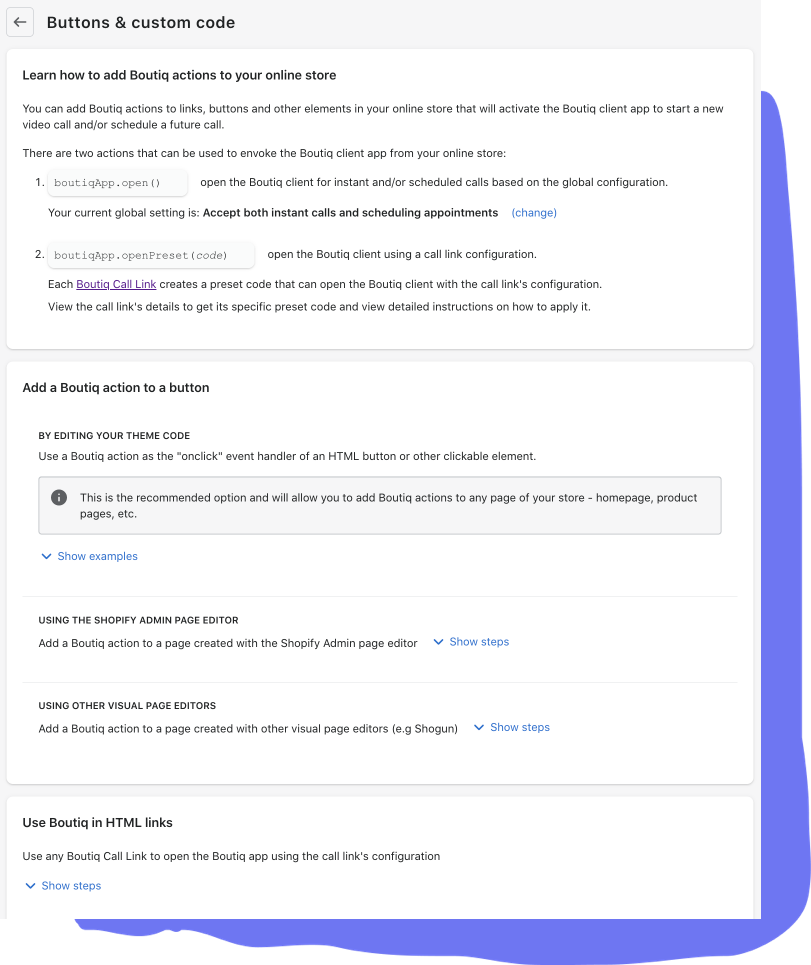
Similarly, you can customize the Boutiq client app (the pop-up window that will be shown when your customer clicks the Boutiq widget or call link). Here you can upload your logo, change the accent and button color to fit your brand/website colors, and choose the corner style (sharp or rounded).
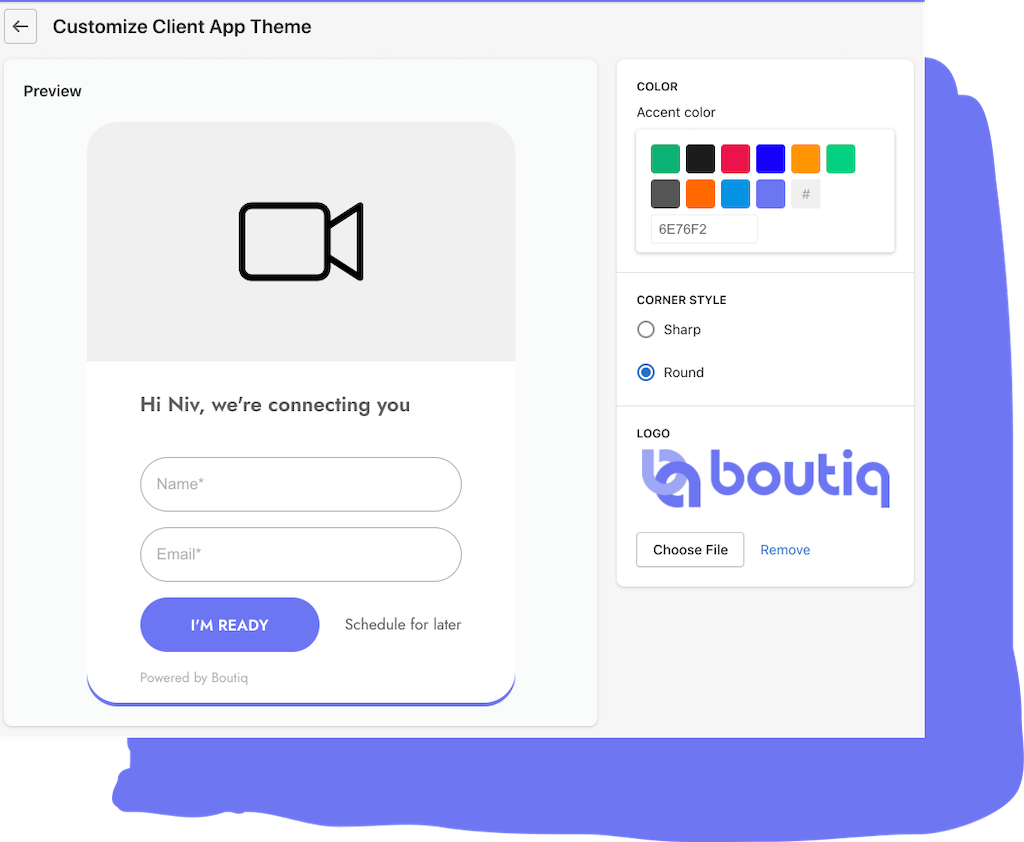
Beyond the styling choices, you also have the opportunity to customize the experience and messaging to your clients when the Boutiq client app launches:
You can upload a short video (Boutiq Story) to welcome your customers and introduce them to the service. You can also customize the Welcome Screen by editing the copy/messaging, uploading a background image, overlaying a color, and showing avatars/profile pictures of your sales associates. All of these are simple no-code options to choose from.
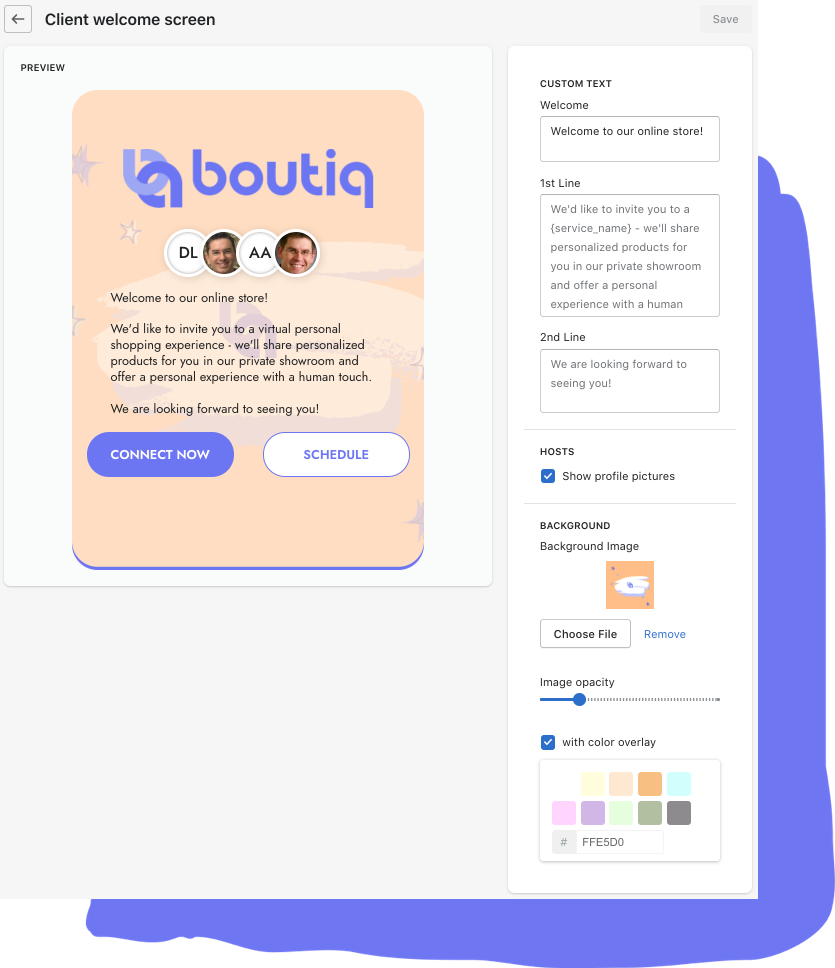
In addition, you can customize the notification emails your clients receive when confirming appointments - you can upload your logo, edit the copy/messaging, and choose the accent color.
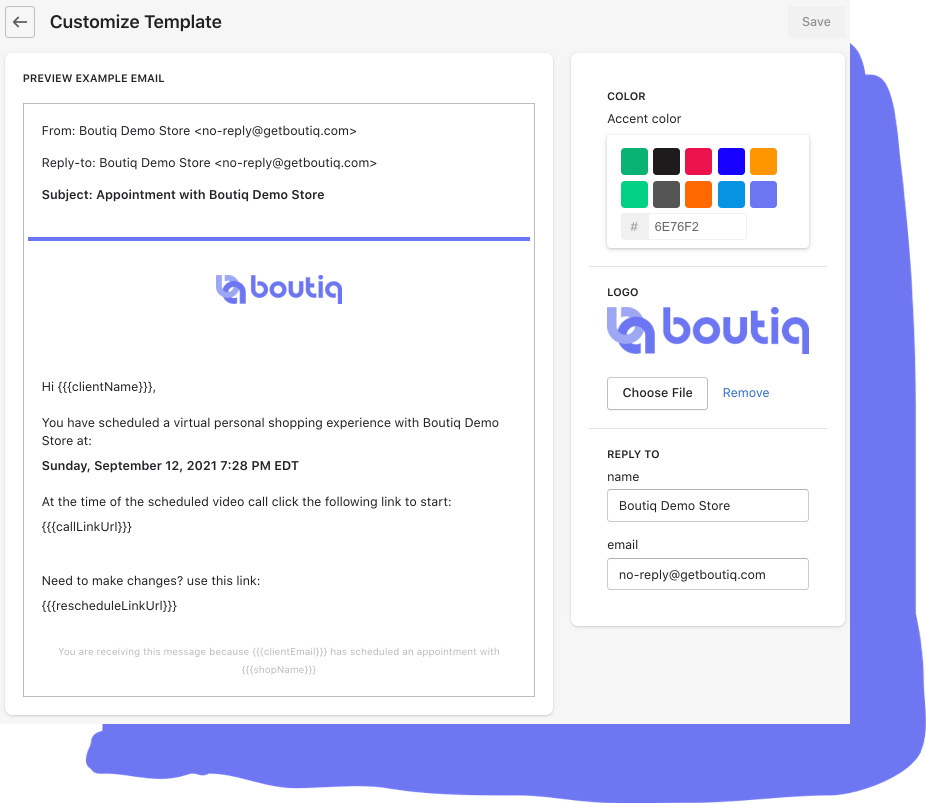
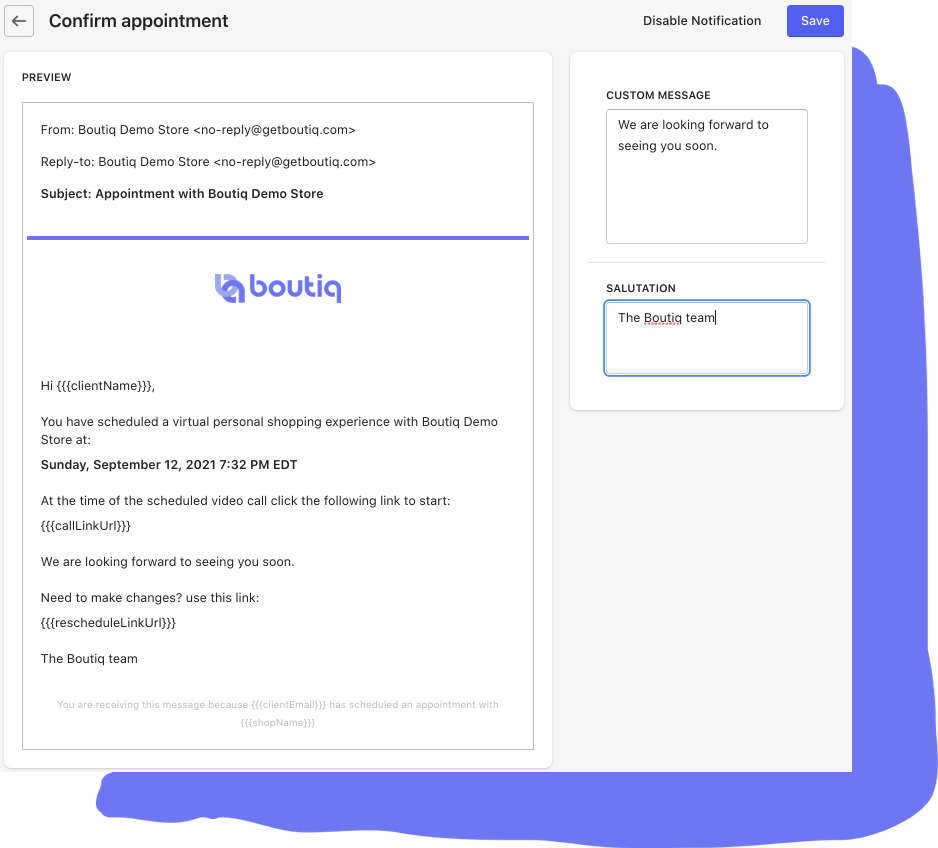
Video shopping is a fairly new concept - chances are your customers are not looking for it when visiting your online store. Conversion on video calls is high - much better than your typically online store conversion and more comparable to physical-store conversion and even better. But at least initially, you’ll need to encourage engagement proactively.
So how to do that? We’ve seen quite a few approaches that increase engagement effectively, especially when you use more than one. Like many other tools (e.g. email marketing), repetition, frequency, and A/B testing are your friends.
Let’s start with integration to your website. Using the Boutiq widget is easy and works but you can get more engagement by adding Boutiq in other sections as well. Many merchants add a dedicated landing page (many times linked from the top menu) for personal video shopping. This is an opportunity to provide more education to your customers (remember, most of them have never used a service like this before) and present a more exclusive experience. Banners also increase engagement.
As a starting point, you can use the Boutiq template landing page and then customize it with your own image(s) and copy using the Shopify Page Editor.
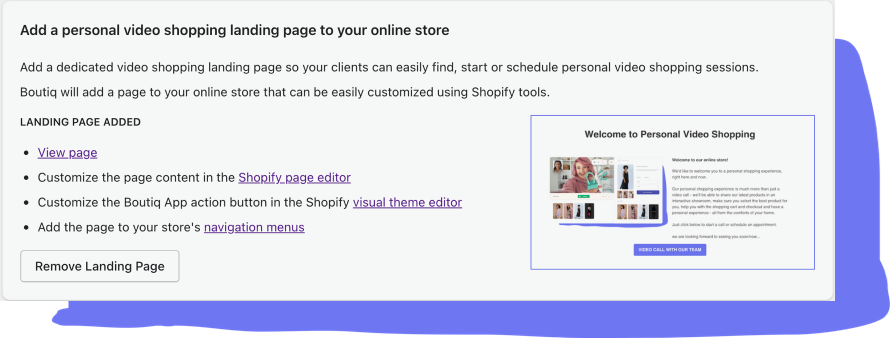
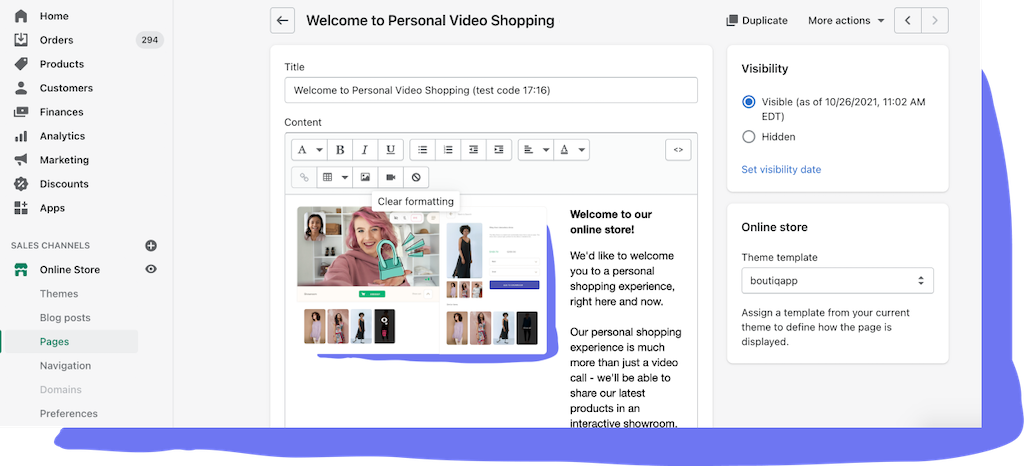
You can also customize the Boutiq button CTA action (appointment only or also instant calls) and look and feel.
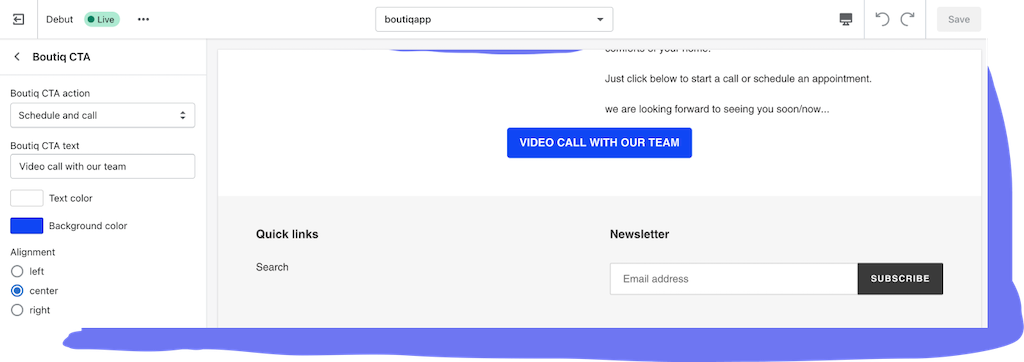
Product-page buttons improve engagement with the added benefit of connecting with your clients when they hesitate whether to add an item to the cart. This high-intent moment results in very good engagement and conversion. (And a side benefit of this strategy is that it minimizes the cases where clients initiate a video-call for support.)
Time-based and/or scroll-based automatic actions work here as well. They can be gentle (e.g. expanding the helper text for the Boutiq widget after a few seconds) or more aggressive (pop-ups).
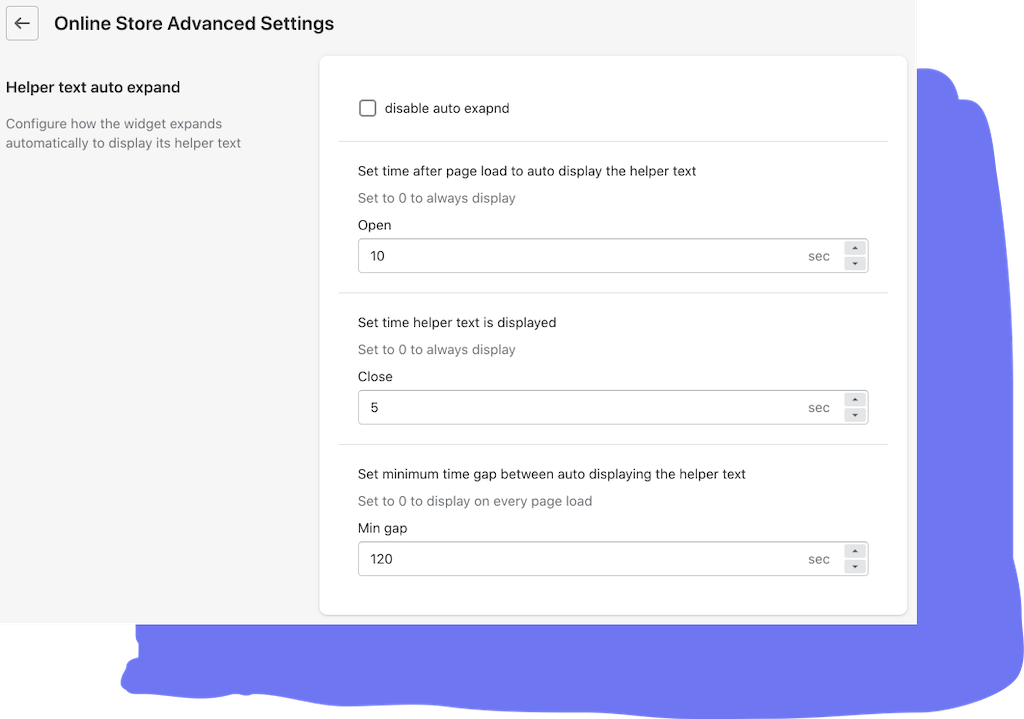
Campaigns are a great way to increase engagement. You can create multiple campaigns, each with its own customized appearance, messaging, trigger conditions and action. For each campaign, you can configure the triggers based on the URL, time spent on the page, and/or whether the store is within business hours. The campaign will pop-up proactively based on your triggers and will encourage your store visitor to start a call and/or schedule one.

Education is also important. Your customers probably never used video shopping and most likely did not come to your website looking for it. A landing page is a good place to start but you can also use email marketing and social media.
A Boutiq Story is a short video (typically anywhere from 10-15 seconds and up to 20-30 seconds) that is being displayed after a customer clicks the Boutiq widget (or button/link). It is a great opportunity for you (store owner, designer, sales associate, actress, …) to welcome them to the store and provide education on what to expect on the call.
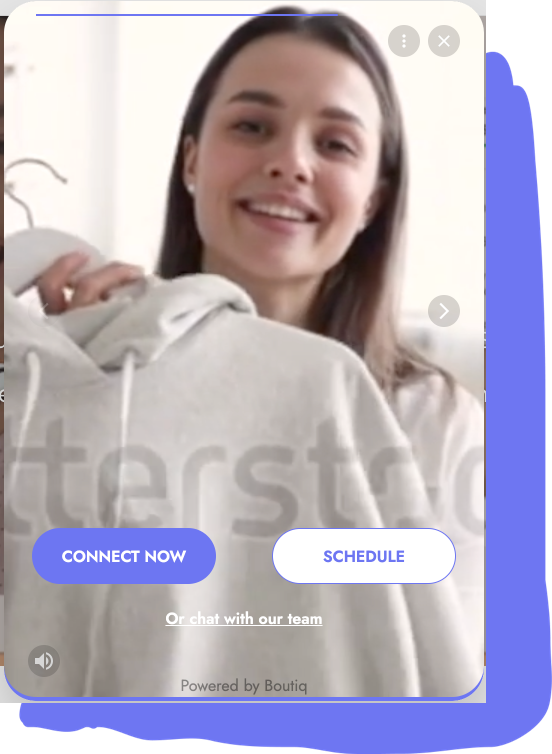
At least initially, personal invitations improve engagement significantly. Some best practices we’ve seen being deployed effectively:
- Depending on your brand voice, "exclusive" language might work better than just "video call" - something that feels more like a VIP exclusive experience. For example: "personal virtual shopping".
- If there is a relationship with one of the sales associates then a personal invitation from her/him (sometimes just a simple email that doesn't look automated) works better.
- Messaging that looks special or one-time-opportunity works better - for example: a personal invite for a session with the designer/owner/expert...
- For some merchants, “virtual fitting” messaging creates more engagement - it’s a smaller “ask” from the client, and many clients feel like they need help with sizing/fitting while shopping online.
Integrating with existing communication channels is also important. Many merchants include invitations to virtual personal shopping experience in their standard email marketing sequences (e.g. abandoned cart workflow, post-purchase, blog content), in email signatures, in social media postings, and in general in every communication channel they’ve been using.
A/B testing helps craft the right copy, frequency, and overall approach. This is the best way to determine what works best for your brand - for example:Call to action - invite to schedule an appointment vs an invite to call now, invite with a link to the app vs to your landing page, and moreEmail marketing copy - A/B testing helps craft the best copy for your clientele
Repetition improves engagement - likely most people don't open every one of your emails... and in general a seed you plant in one email can bring results in the next email or after a few weeks.
It’s a good practice to use Google Analytics and Facebook Pixel for attribution - specifically, tracking which channels result in better engagement and conversion.
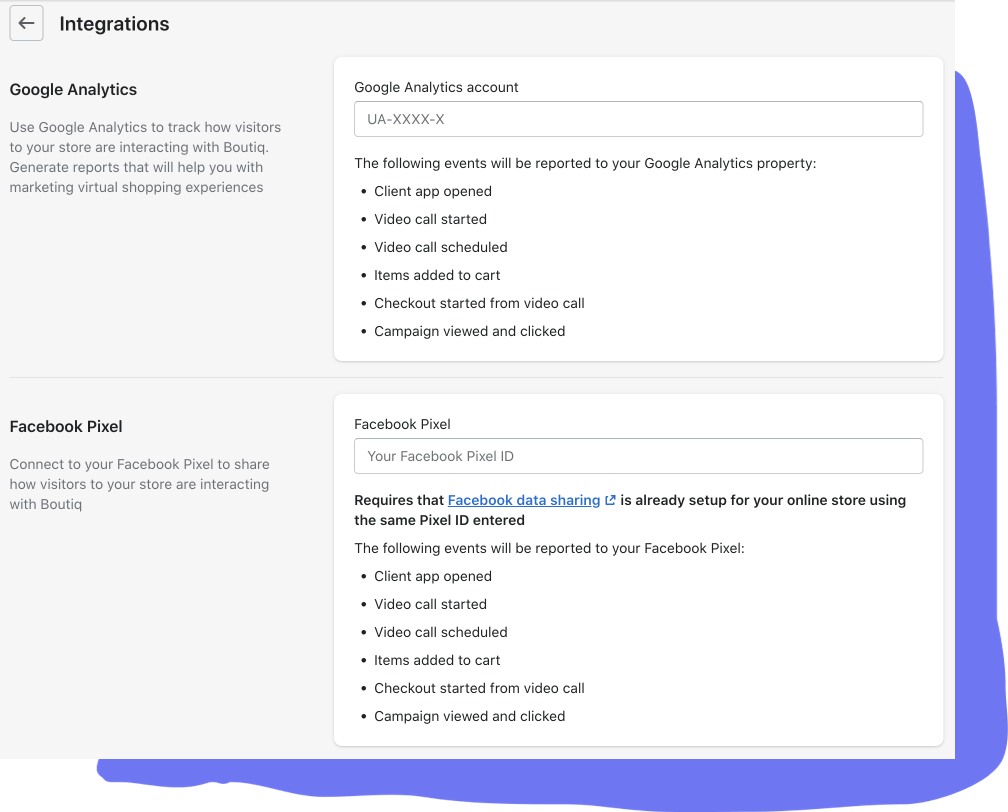
So you got your client to engage and go on a call with you. What’s next? Beyond the standard sales techniques every sales associate is familiar with, what else can you do to increase conversion?
Boutiq comes with built-in tools to increase conversion - before, during and after the call.Of-course the app itself was designed to provide the best experience for the client while empowering your sales associates to serve her better by integrating into your client database, product catalog, and shopping-cart/checkout. The interactive showroom is the center of the conversation - it allows them to discover, select, and share the best items for your client. Make sure your sales associates have been trained and tried a couple of test calls before serving your clients.
In the cases where calls are being scheduled (by appointment), you have the opportunity to prepare for the call. You can do that by asking your clients to answer some questions before the call.
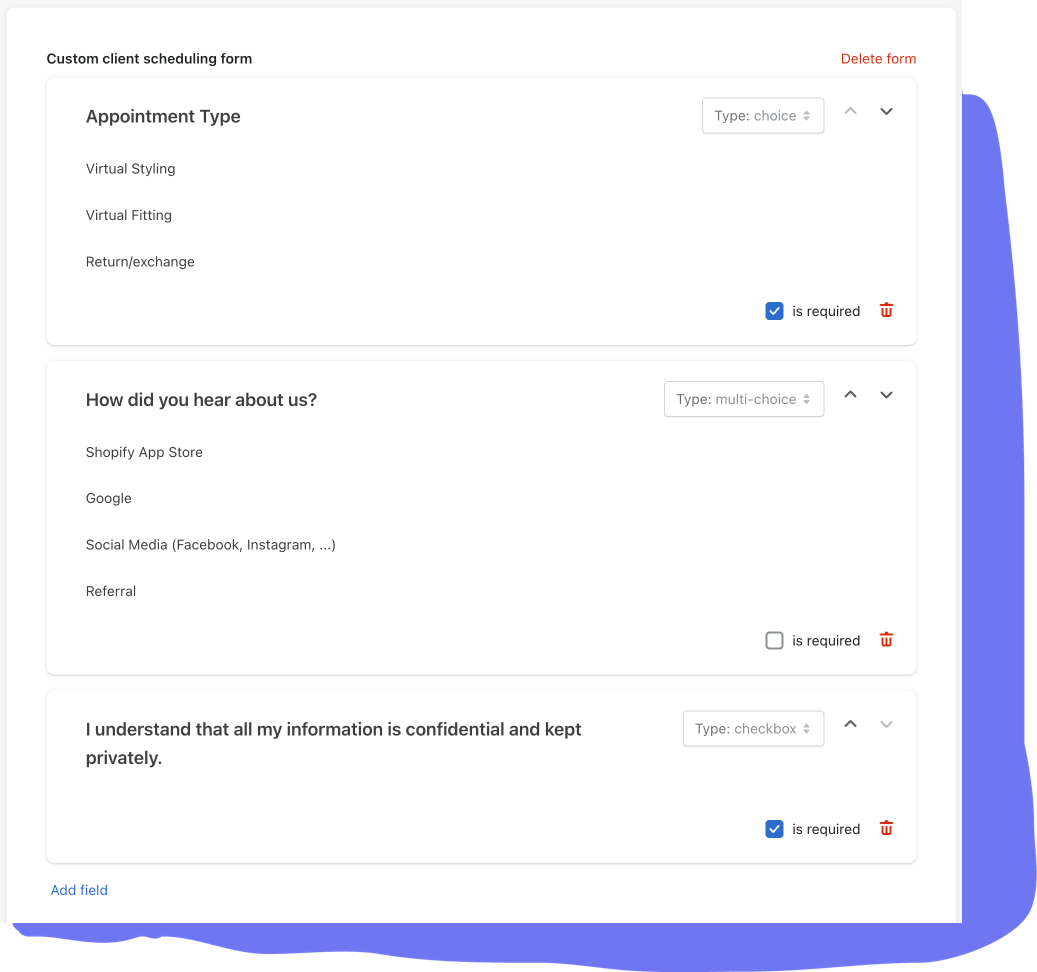

Using the questionnaire responses, the client profile in your CRM, and even checking her social media accounts, you can better prepare for the call. You can also prepare a personal showroom (AKA lookbook or collection) for her - ready to share on the call. This can be done from the Host Webapp similarly to how you create a showroom on a Boutiq call.
On the call, you also have the option to apply a discount to the client’s cart.

After the call, you have the opportunity to follow up with your client using your existing tools (e.g. Klaviyo and other email marketing tools) or send a personal follow-up email including a link to a shopping cart.
For example, if the call resulted in a sale, you might want to automate a personal message as part of your post-purchase workflow. (Hint: add a split/fork based on tags that contain the text “BoutiqApp”)
If the result was an abandoned cart, that’s an opportunity to tweak your abandoned cart message to be more personal and relevant. (Hint: add a fork/split based on cart attributes that contain the text “boutiqapp”.)
For Klaviyo, you can generate events from the Boutiq Admin UI and use them in your abandoned cart flow. (Hint: use a conditional split for a person that has ‘Boutiq Checkout Started’ at least once since starting the flow)

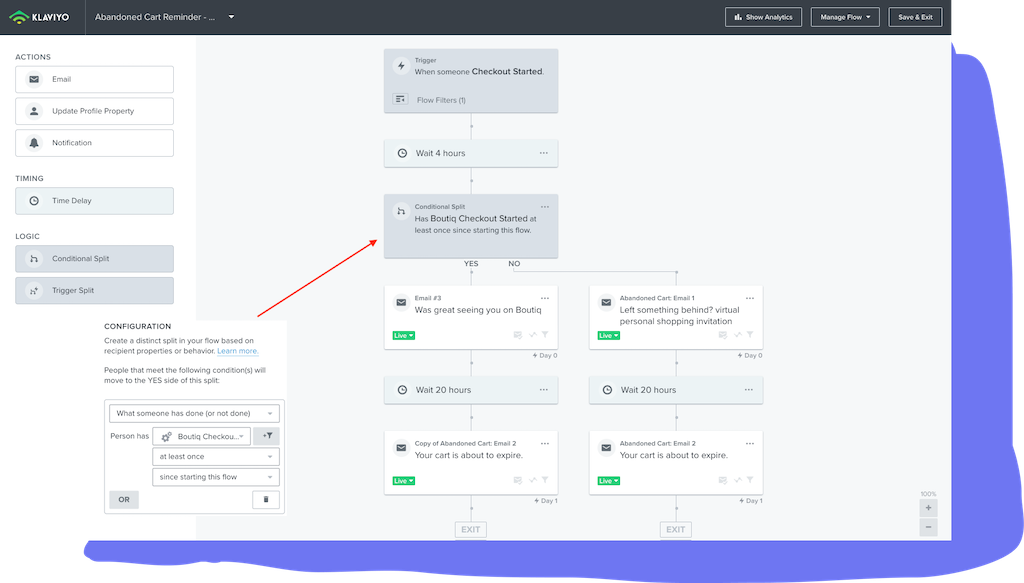
The Boutiq Dashboard aggregates all the stats you need to monitor the performance of your sales associates over time. The KPIs include number of calls, conversion, sales, AOV, and more.
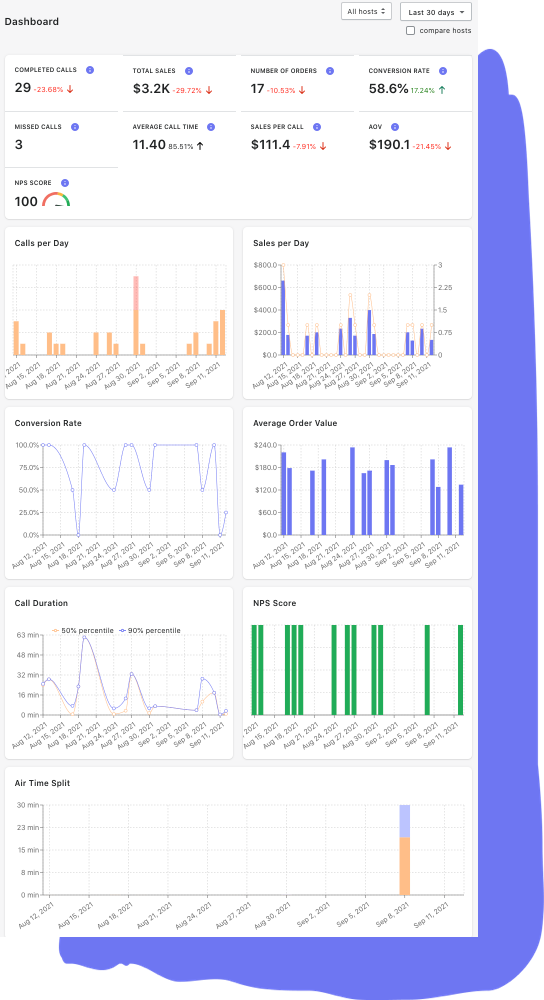
In addition you have a detailed report that includes a log of all the calls including which calls resulted in a sale and who was the sales associate on the call. If your sales associate compensation is based on commission, you can use this report to track and compensate them.
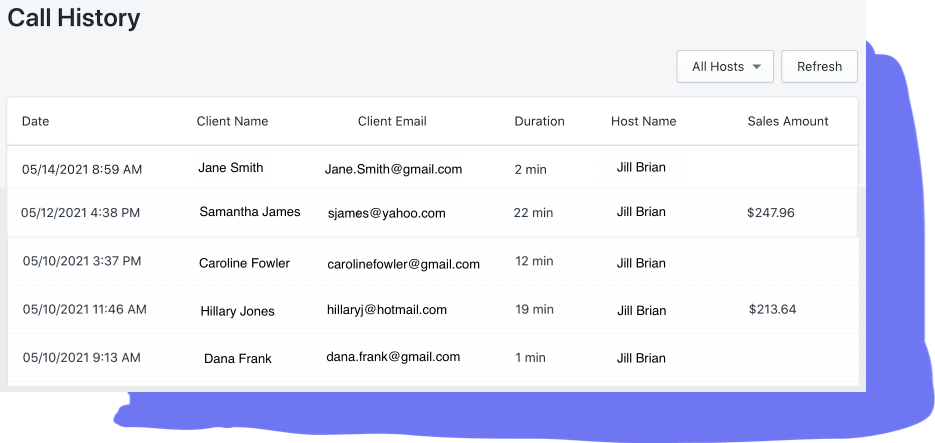
With time, Boutiq will become another sales channel for you - in addition to your online store, your brick-and-mortar stores (if you have ones), and maybe Instagram/Facebook and other sales channels. As such, there might be other more advanced workflows to integrate with.
Every email sequence is an opportunity to offer engagement via personal video shopping. For example, when a customer leaves your store with an abandoned cart, you likely have a workflow that kicks in to try and convert them. (if you don’t, then you should…) Now you can insert into the flow an invitation for a personal shopping experience.
The same logic applies when a customer just bought something - you likely have a post-purchase email workflow - why not invite them to a follow-up personal shopping experience to thank them and upsell additional products.
Many merchants already have a chat service on their online store - Boutiq can work together with your existing chat. Chat is a great tool to address simple customer questions - typically related to order status and returns. Many of them can be automated by a bot.
Some of our customers have an existing and separate chat service/widget and choose to continue and use it. These services tend to have a complete set of chat-related features and are optimized for transactional questions such as order status and returns.
In these cases, you can choose to disable the chat feature in the Boutiq Admin UI.
You can also use the drag-and-drop positioning tool in the Boutiq Admin to position the Boutiq widget next or across your existing chat widget, or implement Boutiq not as a widget.
You can empower you customer care team to transition from a third-party chat session to a personal video call by using the Boutiq Call Link or Host Link.
Some of the third-party chat services serve also as a help-desk center by aggregating customer communication from multiple sources (e.g. email, social media). You can direct Boutiq messages (e.g. messages that your customers leave when there's a missed call or when the store is outside of business hours) to the same service by making sure the Store Contact Email in Boutiq is forwarded to the third-party help-desk software.
Looking for something else? email us at
support@getboutiq.com